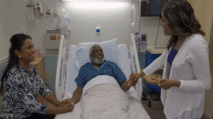Innovation
VR Vision | Apple | Online | Gaming
Innovation For Problem-Solving
Innovation is bringing two existing things together and create something new. Sometimes, doing something differently could be innovative. Innovation is most meaningful and fulfilling when it happens to solve problems. I have been blessed unexpectedly with several opportunities of innovation during my career. Read about my story here.
Healthcare is not new, neither is virtual reality (VR). Bringing the two existing entities together is innovation for both VR and healthcare. Several organizations around the world are working in this new innovation space. The defining moment is leading this new space to solve real-world problems in healthcare. The COVID pandemic has expedited this journey. It’s our goal to collaborate with other like-minded healthcare VR visionaries and make this world a better place, especially during the unprecedented challenging times of the pandemic.
Health VR Project
VR Solutions
Problem-Solving
Pediatric Patient Experience VR
The VR experience is designed to prepare pediatric patients and their family before arriving for a medical procedure. It not only sets realistic expectations but also aims at reducing anxiety, stress, and if the unknown. Experiencing beforehand what they will see, who they will meet, and most importantly where and how the pediatric patients are separated from their family before going into surgery.
Patients and families don’t know what to expect and in general have anxiety, stress, and fear of unknown before a medical procedure. This problem has become more complicated due to the pandemic.
Cloud VR Clinicals
After a successful pilot of 3 Cloud VR clinical scenarios, 12 additional clinical scenarios are slated for deployment real-time via the Cloud VR engine. During the pilot, 6 Nursing students were in their respective homes donning Oculus headsets interacting real-time in the cloud with two clinical instructors in their respective offices supported by a staff from his home. Although the Cloud VR clinicals are meant to mitigate COVID challenges, it has the potential to supplement clinical requirements of Nursing training for a national online nursing program as well as standardizing clinical training across the systems and state lines.
The lockdown at the hospital and on campus have presented unprecedented challenge to the maintaining the clinical training for the Nursing program. The other challenge is clinical instructor variations that cause inequity of clinical training.
Pyxis VR Training
The Pyxis VR is a first-person interactive VR developed in Unity and designed to train Nursing students and onboard graduate nurses in accessing and retrieving medication in a highly secured environment. The immersive experience is not only authentic but also vicarious. For example, during a clinical rotation, one student raised her hand when the clinical instructor asked if anyone had seen Pyxis. When she said she saw it in VR, she was challenged on the spot to apply her skills learned in VR. To the clinical instructor’s great surprise the student did not make a single mistake going through the entire complex Pyxis procedure!
The Pyxis secured medication room has been a training challenge for the Nursing students. The training issue has been identified as a variable in Nursing training in a doctoral dissertation. The lack of an actual Pyxis simulation room further complicates the onboard process.
Chaplain Rounding VR
The Chaplain Rounding VR is a grant funded project over three years for researching the equivalency of VR and in-person experience. At the core of the VR research is the development of empathy and spiritual care for patients. Four VR scenarios produced for the first year were put together as a 35-minute experience for students. Thus far, students have indicated that VR experience are impactful and some even thought it was more impactful than in-person because there was no distractions in the VR environment. One student said she finally understood the difference between sympathy and empathy!
After four years of implementation, the overwhelming success of the in-person chaplain rounding for the graduate programs resulted in a severe scheduling backlog. It became very difficult to schedule a 2-hour block with a hospital chaplain to experience interacting with patients from a non-clinical perspective. Since it was a transformative experience for graduates, it was presented as a problem for VR to solve, in preparation for a wider roll out to the rest of the undergraduate programs.




